|
|
Dedicated to Joel M. Johnson as per personal communication with Diane Johnson, (Smerinthus ophthalmica; April 29, 2018); April 29, 2018
Updated as per James P. Tuttle's The Hawk Moths of North America, April 29, 2018
Updated as per BAMONA, April 29, 2018
|
Sanpete County, Utah and
Other WC Utah Counties: Millard, Servier, Beaver, Piute
Sphingidae
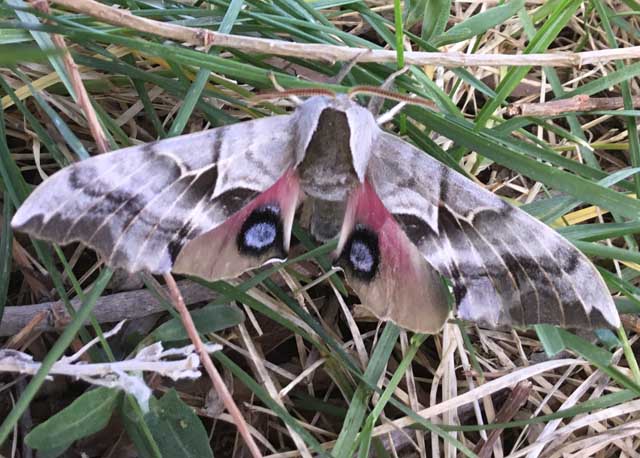
Smerinthus ophthalmica, Mayfield, Sanpete County, Utah,
courtesy of Philip and Diane Johnson.
This page is dedicated to Joel M. Johnson (Poppy), collector and grandfather to photographer Phillip Johnson, with image submitted by
Diane Johnson. Poppy's collection was donated to Brigham Young University after his passing in 2009.
Twenty-five Sphingidae species are listed in the USGS for Utah. Not all of the species
(only seven species:
Pachysphinx modesta Modest sphinx;
Paonias myops Small-eyed sphinx;
Smerinthus cerisyi One-eyed sphinx;
Sphinx dollii Doll's sphinx;
Sphinx vashti Vashti sphinx;
Hemaris thetis Thetis Clearwing;
Hyles lineata White-lined Sphinx)
are reported by USGS, now BAMONA, in Sanpete County.
Pachysphinx occidentalis Big poplar sphinx is documented in Millard County; Sphinx drupiferarum Wild cherry sphinx is documented in Beaver County.
It is hoped that this checklist, with the thumbnails and notes, will help you quickly identify the moths you have encountered or are likely to encounter in
western central Utah.
A WO" after the species name indicates that I have no confirmed reports of this species in Sanpete County, but I
(William Oehlke) expect that this moth is/may be present. I feel this checklist is also valid for nearby counties in central western Utah.
A BAMONA indicates the moth is reported on the USGS website (now BAMONA) and/or in Moths of Western
North America, #2. Distribution of Sphingidae of Western North America, revised, an excellent little booklet available through Paul Opler.
Please help me develop this list with improved, documented accuracy by sending sightings (species, date, location), preferably with an
image, via email to Bill Oehlke.
Sphinx chersis, Sphinx perelegans and Sphinx vashti are quite similar. Note the dark upper thorax with wide black bars extending to the abdomen on
the image of Sphinx perelegans. In Sphinx chersis the entire thorax is uniform light blue-grey with very narrow dark lines.
Sphinx vashti lacks the checkered fringe on the hindwings.
Sphinginae subfamily
Sphingini tribe:
 |
This species has not been reported in Sanpete County, but may be there
as a rare stray. The moth is a very strong flier and is frequently
encountered far north of its usual range.
|
 |
This large bodied moth flies in tobacco fields and vegetable gardens
(potatoes, tomatoes) and wherever host plants are found. I suspect it is in Wayne County. |
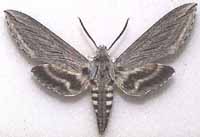 |
This species is not recorded in Wayne County, and would be unlikely.
It flies in pinyon-juniper woodland and similar arid situations in
Colorado (specimen type locality) and Nevada, Utah,
Arizona and New Mexico. |
 |
Sphinx chersis
WO, the Northern Ash Sphinx or Great Ash Sphinx
The upperside of the forewing is soft dark-gray to blue-gray with
a series of black dashes, one reaching the wing tip. Note grey thorax with narrow black lines.
|
 |
This species is not reported for Wayne County.
I only see them only occasionally on P.E.I. despite visiting lights frequently.
|
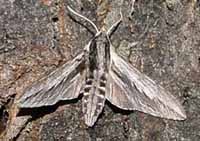 |
This species is not reported for Wayne County but may be present. It flies in arid brushlands and desert foothills. |
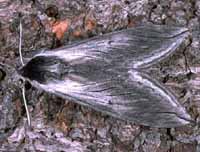 |
Sphinx perelegans adults fly in montane woodlands and mixed chaparral-type vegetation as a single brood
in the north, with adults mainly on the wing in June and July.
It flies from dusk until after midnight. Note dark thorax. |
 |
Sphinx vashti
BAMONA, the Snowberry Sphinx,
Snowberry Sphinx adults fly as a single brood in montane woodlands and along prairie
streamcourses from April to August, usually further
north.
The upperside of the forewing has a narrow black subterminal line
bordered by a white inverted V-shaped line on the outside, and a
black line at the apex. |
Smerinthini Tribe:
 |
Pachysphinx modesta BAMONA,
the Modest Sphinx or Poplar Sphinx,
This large poplar/willow feeder is possibly in Wayne County.
They are a heavy bodied species.
|
 |
This one is quite similar to Pachysphinx modesta, with modesta
being smaller and darker.
Moths should be on the wing from June-August.
|
 |
Paonias myops BAMONA,
the Small-eyed Sphinx
This small species is probably probably present as it
ranges across North America.
The hindwings have a small blue eyespot ringed with black on a yellow background.
|
 |
Smerinthus cerisyi
BAMONA, the Cerisyi's
Sphinx or One-eyed Sphinx, Larvae feed on poplars and willows.
Flight would be from late May-July as a single brood.
|
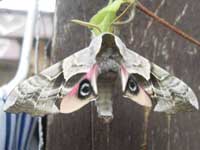 |
Smerinthus opthalmica
DJ/PJ
Larvae feed on poplars, aspen and willows.
Note different shape of double arced forewing pm line compared to the straighter pm line of cerisyi, directly above.
S. ophthalmica has smoother scalloping of the fw outer margin.
|
Smerinthus ophthalmica, Mayfield, Sanpete County, April 29, 2018, Phillip and Diane Johnson.
Macroglossinae subfamily
Dilophonotini Tribe:
 |
Hemaris senta
WO, the Rocky Mountain Clearwing,
There is probably a single brood of this montane species from May-August. The moth is seen along streamsides and in meadows in
mountainous areas. I believe senta is a junior synonym of thetis. |
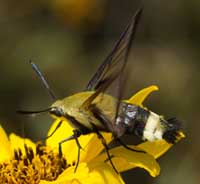 |
Hemaris thetis BAMONA, the Thetis Clearwing or Bee Hawk Moth,
The moth flies along forest edges and in meadows, gardens and
brushy fields. Day-flying adults nectar at lantana, dwarf bush honeysuckle,
snowberry, orange hawkweed, thistles, lilac, Canada violet, etc.
|
Philampelini Tribe:
 |
This moth is not recorded for Wayne County,
but it may be present wherever grapes are found.
Fight would be from June to August. Larvae feed on grape foliage. |
Macroglossini Tribe:
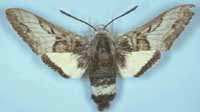 |
Euproserpinus wiesti adults fly, during the day, over sand washes
and prairie blow-outs as a single brood from May-June. |
 |
Hyles lineata BAMONA, the White-lined Sphinx
Adults usually fly at dusk, during the night, at dawn, and during the day. Moths nectar at salvia and oviposit on a number of different
plants. |
|
|
Use your browser "Back" button to return to the previous page.
This page is brought to you by Bill Oehlke and the
WLSS. Pages are on space rented from Bizland. If you would like to become a "Patron of the Sphingidae Site", contact Bill.
Please send sightings/images to Bill. I will do my best to respond to requests for identification help.
Enjoy one of nature's wonderments: Live Saturniidae (Giant Silkmoth) cocoons.
Visit Utah Catocala: Underwing Moths.

